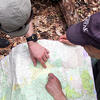Now that you've set up base camp, it's time to do a little exploring! Grab your pack and put on your boots (or sneakers). It's time to go hiking!
Hiking consists of walking in natural environments. While often equated to mountainous or hilly regions, any scenic terrain will do, from the trails in your local park to the woods near your backyard!
Studies have confirmed the health benefits of different types of hiking, including decreasing hypertension, improving mental health and increasing physical fitness.



